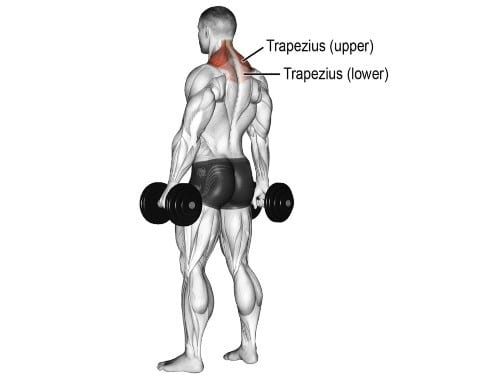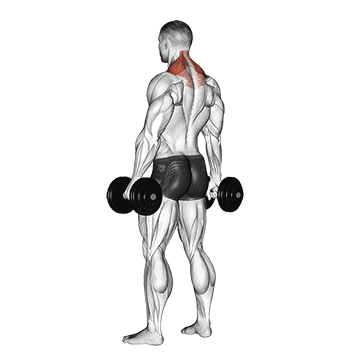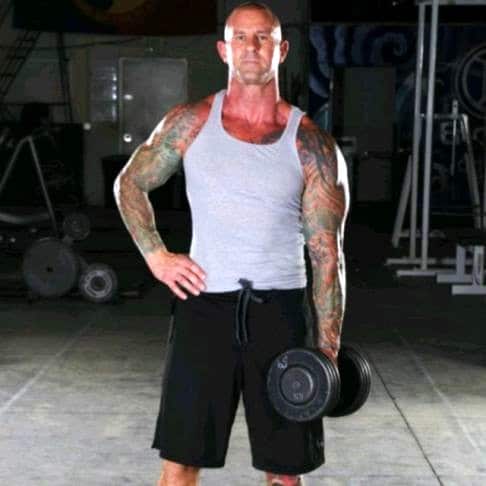If you want to build massive traps, then you are in the right place. Here, you will learn how to build massive traps with the dumbbell shrug exercise.
If you neglect your traps and fail to strengthen them alongside the other muscles in your back, it can lead to poor posture, decreased performance, and even injury down the line.
The dumbbell shrug is a great exercise for building shoulder strength, improving posture, and relieving neck and shoulder pain.
In this article, we will discuss the following:
- What is a dumbbell shoulder shrug?
- Muscles Worked
- How To Do
- Variations

- What Is Dumbbell Shoulder Shrug
- Dumbbell Shoulder Shrug Muscles Worked
- How To Do Dumbbell Shrug
- Dumbbell Shrug Form and Tips
- 4 Best Dumbbell Shrug Variations
- 1. Incline Dumbbell Shrug
- 2. Seated Dumbbell Shrugs
- 3. Behind-the-back dumbbell shrugs
- 4. Single Arm Dumbbell Shrugs
- Dumbbell Shrug Benefits
- Add Dumbbell Shrug Into Your Workout Routine
- I. During Shoulder Workout
- II. During Pull Workout Split
- III. During Upper Body Workout
- FAQ
- What do dumbbell shrug work?
- Can you do dumbbell shrugs sitting?
- Are dumbbell shrugs effective?
- How Many Sets and Reps Should I Do For Dumbbell Shrugs?
- Conclusion
What Is Dumbbell Shoulder Shrug
Dumbbell shrugs, also known as dumbbell shoulder shrugs, are an isolation exercise that targets the upper trapezius muscle.
This exercise can be done with a medium to heavy dumbbell to increase the trap thickness.
In this exercise, you lift a pair of dumbbells using your shoulders and make a shrugging motion while keeping your arms straight.
It is a simple yet effective exercise that strengthens the shoulders, upper back, and neck muscles. They are suitable for both beginners and pros.

Dumbbell Shoulder Shrug Muscles Worked
Dumbbell shoulder shrugs primarily target the upper trapezius muscle.
However, this exercise also works several other muscles in the shoulder and upper back region, including:
- Levator scapulae
- Rhomboids
- Middle Trapezius
- Rear Deltoids
- Rotator cuff muscles

How To Do Dumbbell Shrug
- Stand with your feet shoulder-width apart, and hold a dumbbell in each hand with your arms extended by your sides.
- Keep your shoulders relaxed and your core engaged.
- Inhale and lift your shoulders towards your ears, making a shrugging motion.
- Hold the contraction for a second or two, then exhale and lower your shoulders back down to the starting position.
- Hold the shrug for a second, then slowly lower the dumbbells back down to the starting position.
- Repeat for 10–12 repetitions for 2–3 sets.

Dumbbell Shrug Form and Tips
- Keeping your arms straight (slight bend in the elbows is okay).
- Avoid rolling your shoulders forward or backward.
- Focus on lifting your shoulders straight up towards your ears.
- Don’t hold your breath while performing the exercise.
- Inhale when you lower the weight and exhale when you lift.
- Engage your core and keep your back straight throughout the exercise.
- Avoid rolling the shoulders forward or back as you shrug.
- Don’t let your chin jut forward as you reach the top of the shrug. Maintain a neutral neck position.
- Adding a pause at the top of the movement can help to enhance the mind-muscle connection.
- Limit momentum and excessive jerking or bouncing of the weight.
- Resist the urge to sink your neck into your shoulders by keeping your chin up. You’ll go higher with each rep.
- Incorporate proper warm-ups, rest, and nutrition into your exercise program.
4 Best Dumbbell Shrug Variations
Once you’ve practiced the standard dumbbell shrug, consider trying these variations:
1. Incline Dumbbell Shrug
The Incline dumbbell shrug is a variation of trap dumbbell shrug exercises that strengthen the upper part of the trapezius and neck region.
This shrug variation will shift emphasis to the upper traps and the upper portion of the middle traps.
Because your chest is pressed against the bench, it will be difficult to use momentum to drive the weight up.

How To Do
- Grab a pair of dumbbells and straddle an adjustable-incline bench with your feet flat on the floor, or position them on the bench frame to support your body.
- Hold the dumbbells with a neutral grip at your sides and lie chest-down on an incline bench.
- Slowly shrug your shoulders up toward your ears.
- At the top, pause momentarily and contract hard through your traps and rhomboids.
- Slowly lower the weights back to the starting position.
2. Seated Dumbbell Shrugs
If you want to focus on your trap muscles and not your core, try this variation of the dumbbell shrug exercise while sitting.
The seated position allows for better isolation of the upper trapezius muscles, leading to greater strength gains in this area.

How To Do
- Grab a pair of dumbbells and sit down on the bench with your feet flat on the floor.
- Hold the dumbbells with a neutral grip at your sides.
- Shrug your shoulders as high as you can toward your ears.
- At the top, pause briefly and slowly lower the weights back to the starting position.
3. Behind-the-back dumbbell shrugs
Place the dumbbells behind your back during the exercise to target your upper traps, middle traps, and rear delts slightly more than a standard dumbbell shrug.
Having the dumbbell behind you helps keep your shoulders pulled up and back rather than rounded forward.

How To Do
- Stand up straight with your feet at shoulder width.
- Hold a dumbbell with both hands behind your back using a pronated grip (palms facing back)
- Raise your shoulders as high as you can, as if trying to touch them to your ears.
- Hold momentarily, and then breathe in as you relax your shoulders back down.
4. Single Arm Dumbbell Shrugs
Performing one-arm dumbbell shrugs allows for greater isolation of the trapezius muscles on one side of the body at a time.
As the arm is free to move independently and not restricted by the other arm or a barbell, it allows for a greater range of motion than other variations.

How To Do
- Hold a dumbbell in one hand with your feet at shoulder width.
- Let the dumbbell hang down at arm’s length at your side, with your palm facing your body (neutral grip).
- Raise your shoulder as high as possible (imagine trying to touch your ear with your shoulder).
- Squeeze for a brief moment at the top, and then slowly lower all the way back down to the starting position.
- Repeat for the desired reps, then switch sides.
Dumbbell Shrug Benefits
Here are some of the benefits of dumbbell shrug exercises.
- Dumbbell shoulder shrugs are excellent for building strength and mass in the upper trapezius, deltoids, rhomboids, and other shoulder and upper back muscles.
- Weak upper back muscles can contribute to neck and shoulder pain. Shoulder shrugs can help reduce pain and discomfort by strengthening these muscles.
- Traps are tricky to build. There are only a handful of exercises that mainly target your traps. It is one of the best that targets your upper traps.
- It helps build strength in your upper body, stabilizes muscle groups, helps you stand up tall, and keeps your back straight.
- Strong shoulders and upper back muscles are essential for many athletic activities, such as throwing, lifting, and swinging.
Add Dumbbell Shrug Into Your Workout Routine
You can perform shrug exercises as part of an upper body or during Push Pull Leg workout Split.
Dumbbell shrugs can be included in your shoulder workout routine alongside other exercises such as overhead press, lateral raise, and front raise.
A good starting point is to perform 3–4 sets of 8–12 reps.
I. During Shoulder Workout
| S.NO | Exercise | Sets | Reps |
|---|---|---|---|
| 1 | Seated Dumbbell Shoulder Press | 3-4 | 8-12 |
| 2 | Standing Dumbbell Lateral Raise | 3-4 | 10-15 |
| 3 | Dumbbell Shrug | 3 | 10-12 |
| 4 | Front Plate Raise | 3 | 12-15 |
| 5 | Upright Row | 3 | 10-12 |
II. During Pull Workout Split
| S.NO | Exercise | Sets | Reps |
|---|---|---|---|
| 1 | Pull-Ups | 3-4 | 8-10 |
| 2 | Bent Over Barbell Rows | 3-4 | 8-10 |
| 3 | Dumbbell Shrug | 3 | 10-12 |
| 4 | Bicep Curls (with dumbbells or barbell) | 3 | 12-15 |
| 5 | Hammer Curls | 3 | 10-12 |
| 6 | Dumbbell Shrug | 3 | 12-15 |
III. During Upper Body Workout
| S.NO | Exercise | Sets | Reps |
|---|---|---|---|
| 1 | Bench Press (with barbell or dumbbells) | 3-4 | 8-10 |
| 2 | Seated Dumbbell Shoulder Press | 3-4 | 8-12 |
| 3 | Dumbbell Shrug | 3-4 | 10-12 |
| 4 | Lat Pulldowns (with machine or bar) | 3-4 | 10-12 |
| 5 | Cable Tricep Pushdowns | 3 | 12-15 |
| 6 | Bicep Curls (with dumbbells or barbell) | 3 | 12-15 |
FAQ
What do dumbbell shrug work?
The dumbbell shrugs work the upper back and shoulders’ upper trapezius muscles. However, they also engage other muscles, such as the rhomboids, levator scapulae, and deltoids, to a lesser degree.
Dumbbell shrugs can help to improve shoulder and upper back strength, posture, and athletic performance.
Can you do dumbbell shrugs sitting?
Yes, If you want to focus on your shoulder and back muscles and not core stabilization, try this seated dumbbell shrug.
Are dumbbell shrugs effective?
Yes, dumbbell shrug is a simple but very effective exercise. It can build your upper back and shoulder muscles with proper form.
How Many Sets and Reps Should I Do For Dumbbell Shrugs?
Do 3-4 sets of 8–10 repetitions to start. You can increase the number of reps as you build up your shoulder strength.
Over time, try working up to do 3 sets of 20 repetitions, 2–3 times a week.
Conclusion
Dumbbell shoulder shrugs can be added to your workout routine to boost the strength of your neck or upper back muscles.
Choose a weight that allows you to maintain good technique throughout all sets and repetitions.
It is easy to do and requires no more scientific details. If done consistently, the results will speak for themselves.
Thanks for reading!
References
- Pizzari T, Wickham J, Balster S, Ganderton C, Watson L. Modifying a shrug exercise can facilitate the upward rotator muscles of the scapula. Clin Biomech (Bristol, Avon). 2014 Feb;29(2):201-5. doi: 10.1016/j.clinbiomech.2013.11.011. Epub 2013 Nov 26. PMID: 24342452.
- Choi WJ, Cynn HS, Lee CH, Jeon HS, Lee JH, Jeong HJ, Yoon TL. Shrug exercises combined with shoulder abduction improve scapular upward rotator activity and scapular alignment in subjects with scapular downward rotation impairment. J Electromyogr Kinesiol. 2015 Apr;25(2):363-70. doi: 10.1016/j.jelekin.2014.12.001. Epub 2014 Dec 13. PMID: 25553964.
- Lee JH, Cynn HS, Choi WJ, Jeong HJ, Yoon TL. Various shrug exercises can change scapular kinematics and scapular rotator muscle activities in subjects with scapular downward rotation syndrome. Hum Mov Sci. 2016 Feb;45:119-29. doi: 10.1016/j.humov.2015.11.016. Epub 2015 Nov 25. PMID: 26625348.

Manish brings over 10 years of hands-on experience in weight lifting and fat loss to fitness coaching. He specializes in gym-based training and has a lot of knowledge about exercise, lifting technique, biomechanics, and more.
Through “Fit Life Regime,” he generously shares the insights he’s gained over a decade in the field. His goal is to equip others with the knowledge to start their own fitness journey.
